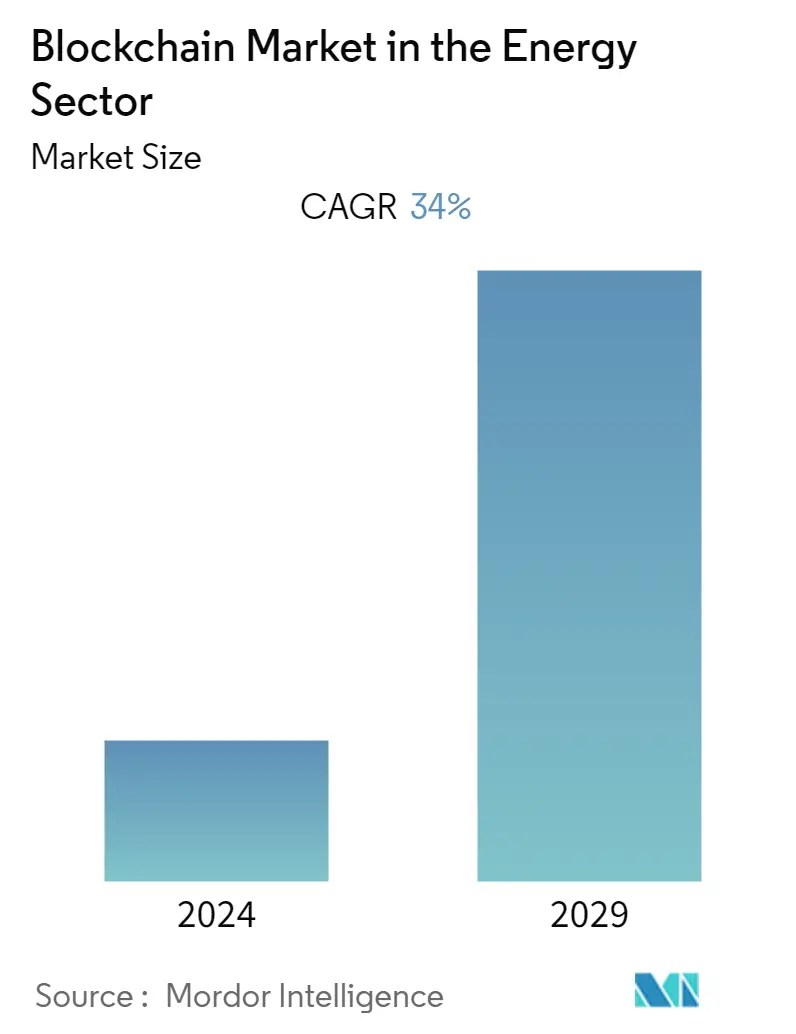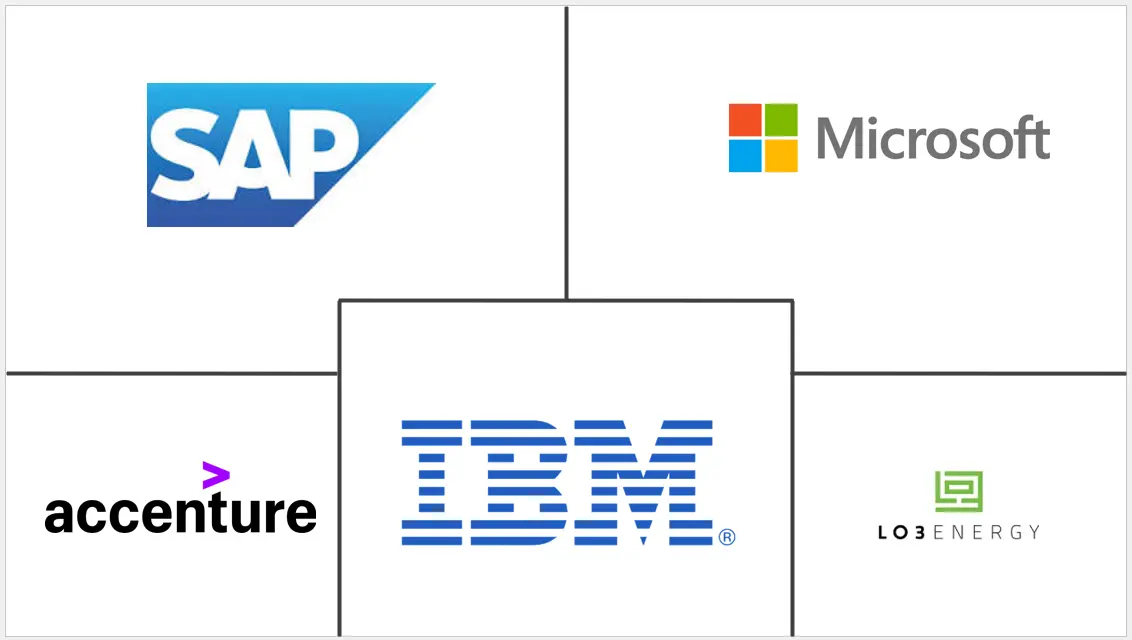Market Size of Blockchain Industry in the Energy Sector

| Study Period | 2019 - 2029 |
| Base Year For Estimation | 2023 |
| CAGR | 34.00 % |
| Fastest Growing Market | Asia-Pacific |
| Largest Market | Europe |
| Market Concentration | High |
Major Players
*Disclaimer: Major Players sorted in no particular order |
Blockchain in Energy Sector Market Analysis
The energy blockchain market is expected to register a CAGR of 34% over the next few years. Because the energy sector is centralized, it has some problems, such as high costs for administration and transmission. Since blockchain solves these problems, reduces the chance of a single point of failure, and makes the whole supply chain more transparent, it is expected to bring a big digital change to the sector.
- Blockchain technology helps regions meet their goals for renewable energy, makes grids more reliable and efficient, and cuts down on the amount of money utilities have to spend on clean energy generation. Thus, its adoption is expected to increase over the forecast period.
- Since microgrids allow electricity to be traded within a certain area and have other benefits during emergencies with the main grid (like acting as backup solutions), vendors on the market could take advantage of the growing use of microgrids. One illustration is the pilot project that German company OLI Systems, which sells energy blockchains, set up in Europe's microgrid.
- The biggest benefits of blockchain in the energy sector are lower costs, less damage to the environment, and more openness among stakeholders without sacrificing privacy.
- Software solutions, such as enterprise Ethereum solutions, can also help traditional energy sectors like oil and gas. With these private blockchain networks, oil and gas companies can protect their privacy and trade secrets by giving only pre-approved parties access to their data and letting them join select consortiums.
- Among significant applications, the 'payments' category exhibited the highest association and implementation of blockchain in the energy sector. By tracking the chain of custody for grid materials, distributed ledger technology can potentially improve utility providers' efficiencies. Beyond provenance tracking, blockchain offers unique solutions for renewable energy distribution.
The COVID-19 pandemic crisis made it more important for people, businesses, and the economy to use digital and energy technologies. The company knew how much it depended on digital and energy solutions to help people work from home, heat their homes, run hospitals, and run their businesses.
Blockchain in Energy Sector Industry Segmentation
Because the energy sector is mostly run from one place, it has some problems, such as high costs for administration and transmission. Blockchain solves these problems, reduces the chance of a single point of failure, and makes the whole supply chain more open. The technology is expected to bring a noteworthy digital transformation to the energy sector.
The blockchain market in the energy sector is divided by application (payments, smart contracts, digital identities, governance, risk and compliance management, and other application types) and geography (North America, Europe, Asia-Pacific, Latin America, the Middle East, and Africa).
The market sizes and forecasts are provided in terms of value (in USD million) for all the above segments.
| By Application | |
| Payments | |
| Smart Contracts | |
| Digital Identities | |
| Governance, Risk, and Compliance Management | |
| Other Applications |
| By Geography | ||||||
| ||||||
| ||||||
| ||||||
| ||||||
|
Blockchain Market in the Energy Sector Size Summary
The blockchain technology in the energy sector is poised for significant transformation, driven by its ability to address challenges such as high administrative and transmission costs associated with centralized energy systems. By enhancing transparency and reducing the risk of single points of failure, blockchain is expected to facilitate a digital revolution within the industry. Its integration is anticipated to support the achievement of renewable energy goals, improve grid reliability and efficiency, and reduce expenses for utilities in clean energy generation. The growing adoption of microgrids, which allow localized electricity trading and serve as backup solutions during grid emergencies, presents additional opportunities for market vendors. The technology's benefits include cost reduction, environmental sustainability, and increased stakeholder transparency without compromising privacy.
The energy blockchain market is characterized by a competitive landscape with major players like SAP SE, Microsoft Corp., Accenture PLC, and IBM Corp. These companies are actively expanding their market presence through strategic collaborations and acquisitions of startups focused on energy blockchain technologies. The market is further bolstered by government initiatives and funding aimed at securing energy grids using blockchain solutions. Notable applications of blockchain in the sector include enhancing payment systems, improving utility efficiencies through distributed ledger technology, and facilitating direct billing and metering processes. The COVID-19 pandemic has accelerated the adoption of digital and energy technologies, highlighting the importance of blockchain in streamlining transactions and reducing overhead costs for utilities. As traditional payment methods become less effective, blockchain continues to advance, addressing issues like hacking and data breaches, and offering innovative solutions for renewable energy distribution and smart grid integration.
Blockchain Market in the Energy Sector Market Size - Table of Contents
-
1. MARKET INSIGHTS
-
1.1 Market Overview
-
1.2 Industry Attractiveness - Porter's Five Forces Analysis
-
1.2.1 Bargaining Power of Suppliers
-
1.2.2 Bargaining Power of Consumers
-
1.2.3 Threat of New Entrants
-
1.2.4 Intensity of Competitive Rivalry
-
1.2.5 Threat of Substitutes
-
-
1.3 Industry Value Chain Analysis
-
1.4 Assessment Of The Impact Of COVID-19 On The Market
-
1.5 Market Drivers
-
1.5.1 Emergence of Variable Electricity Rates and Need for Peer-to-peer Trading
-
1.5.2 Aggressive Spending by Venture Capitalists
-
-
1.6 Market Restraints
-
1.6.1 Scalability Constraints
-
-
1.7 Blockchain In Energy Sector - Use Case Scenario Across The Region
-
-
2. MARKET SEGMENTATION
-
2.1 By Application
-
2.1.1 Payments
-
2.1.2 Smart Contracts
-
2.1.3 Digital Identities
-
2.1.4 Governance, Risk, and Compliance Management
-
2.1.5 Other Applications
-
-
2.2 By Geography
-
2.2.1 North America
-
2.2.1.1 United States
-
2.2.1.2 Canada
-
-
2.2.2 Europe
-
2.2.2.1 United Kingdom
-
2.2.2.2 Germany
-
2.2.2.3 Netherlands
-
2.2.2.4 Rest of Europe
-
-
2.2.3 Asia-Pacific
-
2.2.3.1 Japan
-
2.2.3.2 Australia
-
2.2.3.3 New Zealand
-
2.2.3.4 Rest of Asia-Pacific
-
-
2.2.4 Latin America
-
2.2.4.1 Brazil
-
2.2.4.2 Mexico
-
2.2.4.3 Rest of Latin America
-
-
2.2.5 Middle East and Africa
-
2.2.5.1 United Arab Emirates
-
2.2.5.2 Israel
-
2.2.5.3 Rest of Middle East and Africa
-
-
-
Blockchain Market in the Energy Sector Market Size FAQs
What is the current Blockchain Market in the Energy Industry size?
The Blockchain Market in the Energy Industry is projected to register a CAGR of 34% during the forecast period (2024-2029)
Who are the key players in Blockchain Market in the Energy Industry?
SAP SE (SAP), Microsoft Corp, Accenture PLC, IBM Corporation and LO3 Energy Inc. are the major companies operating in the Blockchain Market in the Energy Industry.

